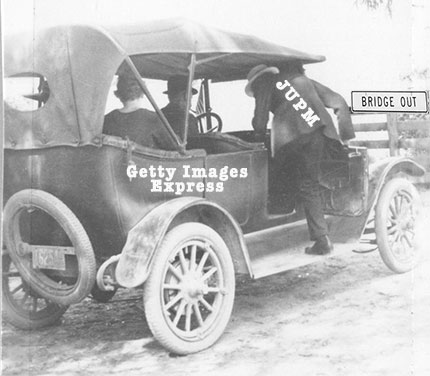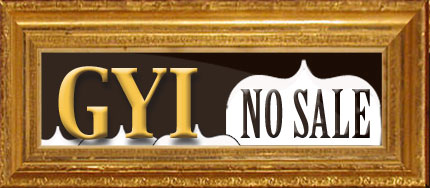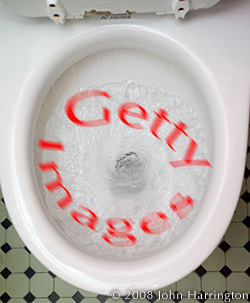Getty Images’ Downward Spiral Approaches Judgment Day
If you owe so much money to others that you can’t even afford to pay the interest accrued on the loan, and there are no promises of large cash influxes in the near future, no one will loan you the money to pay your monthly interest expense, let alone pay down the principal you owe.
Assume you have a $30,000 credit card debt. The interest rate is 17%, so you are required to pay $418.89 a month – just in interest. In this example, using the numbers/income that apply to Getty’s situation, you would only have $52.36 of your income you can use to pay down your debt, thus you have NO WAY of paying off a mounting debt when your monthly increase in debt is 8 times what you have to pay down the debt.I can’t make it more simple than that.
 How did Getty arrive
at this spot? Getty Images first hit the stock market during an IPO on July 2, 1996 on the NASDAQ before moving to the NYSE on November 5, 2002. Much of the public scrutiny on Getty diminished when, after a
disasterous turn in the stock market under what was then the ticker GYI, and it
seemed, for the Getty family to help defend the impending failure of a scion of
the famed Getty family, Mark Getty, one
of the many private equity funds they have a relationship with, Hellman &
Friedman, in 2008 took the company off the stock market and private, where no one had
to see the further decline, and where, according to a March 2012 article on
private equity citing Moody’s (here) notes that “certain Getty family members” were also shareholders. While the taking private of Getty was reported
as a a 2.4B transaction, H&F only “invested up to $941.3 million equity in
Getty as part of the buyout, according toSEC filings.” a pair of dividends in 2010 and 2012 effectively allowed H&F to make back
most of their investment. Enter the Carlysle Group.
How did Getty arrive
at this spot? Getty Images first hit the stock market during an IPO on July 2, 1996 on the NASDAQ before moving to the NYSE on November 5, 2002. Much of the public scrutiny on Getty diminished when, after a
disasterous turn in the stock market under what was then the ticker GYI, and it
seemed, for the Getty family to help defend the impending failure of a scion of
the famed Getty family, Mark Getty, one
of the many private equity funds they have a relationship with, Hellman &
Friedman, in 2008 took the company off the stock market and private, where no one had
to see the further decline, and where, according to a March 2012 article on
private equity citing Moody’s (here) notes that “certain Getty family members” were also shareholders. While the taking private of Getty was reported
as a a 2.4B transaction, H&F only “invested up to $941.3 million equity in
Getty as part of the buyout, according toSEC filings.” a pair of dividends in 2010 and 2012 effectively allowed H&F to make back
most of their investment. Enter the Carlysle Group."EBITDA is essentially net income with interest, taxes, depreciation, and amortization added back to it, and can be used to analyze and compare profitability between companies and industries because it eliminates the effects of financing and accounting decisions."
 While Moody’s dire
reporting was coming out, Getty was finishing 2014 “burned through a third of
its cash in the last three months of 2014 as declining earnings limit the
Carlyle Group LP-controlled photo archiver’s ability to invest and curb its
access to credit…” and as a result, they only have $27 million left. Their
February 23rd disclosure, according to Bloomberg shows a further
decline of 7% for EBITDA, making things even worse.
While Moody’s dire
reporting was coming out, Getty was finishing 2014 “burned through a third of
its cash in the last three months of 2014 as declining earnings limit the
Carlyle Group LP-controlled photo archiver’s ability to invest and curb its
access to credit…” and as a result, they only have $27 million left. Their
February 23rd disclosure, according to Bloomberg shows a further
decline of 7% for EBITDA, making things even worse.  Getty now either has
wholey-owned content of images they represent of approximately 170,000,000
images. Sources with knowledge of how valuators determined the value of that
library-as-an-asset, each image is valued at $0.15 per image. That means the
total valuation of their image library, were it to be sold off now, is
$25,500,000 (that’s 25.5 million). How
many of those are they relying on in the mid-stock segment? According to Getty,
they have just 8 million images that are unique. That means the unique value of
their mid-stock image library is just $1.2 million. Even if the figures are much higher, the reality is that blood is in the water as
Getty competitors, with no debt seek to topple Getty that is bleeding out. Both
Shutterstock and Fotolia are leading competitors in that arena, and a price
war, according to Bloomberg, is now underway. In an era where Getty must
increase revenue, the concept of “selling for less and making it up on volume…”
is just not going to work.
Getty now either has
wholey-owned content of images they represent of approximately 170,000,000
images. Sources with knowledge of how valuators determined the value of that
library-as-an-asset, each image is valued at $0.15 per image. That means the
total valuation of their image library, were it to be sold off now, is
$25,500,000 (that’s 25.5 million). How
many of those are they relying on in the mid-stock segment? According to Getty,
they have just 8 million images that are unique. That means the unique value of
their mid-stock image library is just $1.2 million. Even if the figures are much higher, the reality is that blood is in the water as
Getty competitors, with no debt seek to topple Getty that is bleeding out. Both
Shutterstock and Fotolia are leading competitors in that arena, and a price
war, according to Bloomberg, is now underway. In an era where Getty must
increase revenue, the concept of “selling for less and making it up on volume…”
is just not going to work. Getty could utilize their platform that is already ingrained into the desktops and web-browser bookmarks of publishing entities around the world, and serve as a content platform only. Yet, companies like HBO, which started as a re-seller of movies moved successfully into producing content, and more recently, Netflix did the same thing, again, producing content. Getty is clearly moving away from that model.
Getty could utilize their platform that is already ingrained into the desktops and web-browser bookmarks of publishing entities around the world, and serve as a content platform only. Yet, companies like HBO, which started as a re-seller of movies moved successfully into producing content, and more recently, Netflix did the same thing, again, producing content. Getty is clearly moving away from that model. Each of these
sub-entities could be spun-off or sold-off in a breakup of Getty. Under a
bankruptcy scenario, these assets would all be sold off, but with no clear
entities strongly interested in the assets, they would be for pennies on the
dollar. The limited Getty staff photographers would be looking at the other
wire-services for employment, because most if not all of them are highly
talented. As for images, at 15-cents an image, those 8 million unique images
would, as noted before, be valued at just a $1M or so. Where they will get
anywhere close to the $2B+ they owe will be an exercise that involves a lot of smoke,
mirrors, and a dance I’ve never seen before.
Each of these
sub-entities could be spun-off or sold-off in a breakup of Getty. Under a
bankruptcy scenario, these assets would all be sold off, but with no clear
entities strongly interested in the assets, they would be for pennies on the
dollar. The limited Getty staff photographers would be looking at the other
wire-services for employment, because most if not all of them are highly
talented. As for images, at 15-cents an image, those 8 million unique images
would, as noted before, be valued at just a $1M or so. Where they will get
anywhere close to the $2B+ they owe will be an exercise that involves a lot of smoke,
mirrors, and a dance I’ve never seen before.------------
RELATED - Getty Stories on Photo Business News to Present:
UPDATED: Getty Infringement, 2/24/07When Your Agent is Not Your Friend, 6/14/07About the only good 'Short'-sighted Idea I can find, 7/8/07I told you so? No, not really. (Well, maybe, sort of), 8/4/07Getty Site - Site Down as Stock Is Down?, 8/24/07The 'Virus' is Spreading, 8/29/07JDK's World, 8/29/07UPDATED: GYI - The Downward Full Court Press Continues, 9/6/07Getty's Self-Immolation, 9/12/07UPDATED: Getty (GYI) Hit New 52 Week low, 9/18/07GYI's JDK: "our core stock photography business has stopped growing, in fact, it's declining.", 9/20/07Three Free Men - Getty Images on Lockdown, 9/21/07Photographer's Choice Chance, 9/23/07It's The Witching Hour - Are You Ready?, 10/30/07The Numbers Speak for Themselves - GYI down 30%, 11/1/07Getty Images (GYI) In Decline Again, 1/6/08BREAKING: Getty Images (GYI) Hits 52-Week Low (again), 1/7/08UPDATED: Karma's a (rhymes with witch), 1/8/08Getty, The Stock Market, and Warren Buffett, 1/15/08There's a sucker born every minute - Getty Images For Sale!, 1/21/08JDK - Getty Images' CEO and KKR's Track Record - History Repeats Itself?, 1/22/08Ho Humm. One More Q in Loser-ville for Getty, 2/1/08Getty Images - Down For The Count, 2/11/08Let The Exodus Begin (resume?) While PhotoShelter Picks Up More Talent, 2/12/08Getty Images - A New Beginning?, 2/26/08Getty Images - Moving Forward, 3/19/08Fool's Gold - Getty Images' Future, 4/1/08SI Pictures Boards A Sinking Ship, 4/2/08Assignment vs. Stock - Is Stock Risky?, 5/19/08The Curious Case of Getty and Flickr, 7/11/08The Road To Hell Is Paved With Good Intentions: Getty Images Buys JupiterImages, 10/24/08Micelotta out At Getty?, 2/1/09Getty Flushes Scoopt, 2/3/09Boo Hoo, and Buh-Bye, 3/5/09Getty Images And Paparazzi Pictures, 3/9/09"5 percent of our workforce, will be asked to leave Getty Images", 3/16/09When Do The Musicians Abandon Ship?, 3/17/09Livingstone Out At Getty Images, 3/24/09Getty Makes More Cuts, 3/26/09The Associated Press and the NFL, 4/15/09Getty's Got Game - (A Perfect One), 7/30/09Pushing Pixels: $5 Idiocy, 8/7/09Enter The Efficiency Experts, 8/17/09Getty Images Splitting Sales With Celebrity Subjects on the "DL", 8/30/09Ten Questions for Frank Micelotta, 9/11/09Getty Images - Business Fantasy Update, 10/10/09Tick...Tick...Tick...Getty Images Cuts More Staff, 10/21/09Getty Images and Bloomberg - Futurescape, 11/5/09NFL and the Wayward Getty Images, 4/9/09Getty Images CEO Jonathan Klein - Delusional, Deceptive, or a Liar?, 2/26/10Who Gets Paid What? Getty & Corbis Edition, 4/9/10Getty Images and the Incredibly Shrinking Usage Fee, 5/13/10Getty and Flickr's New Relationship, 6/18/10Stock Loss: Stupid is, as Stupid Does, 2/24/11PicScout Acquired by Getty Images, 5/23/11Getty Images: (Not) Looking for Cash in All The Wrong (Right) Places, 3/23/12Getty Images Returning to the Stock Market with an IPO?, 5/22/12Deception? Getty Images & The Pinterest Deal, 12/13/13Monetizing Getty's 35M Image Archive via FREE Editorial Uses, 3/7/14Getty's Flickr Agreement Ends Like Titanic, 3/11/14
Please post your comments by clicking the link below. If you've got questions, please pose them in our Photo Business Forum Flickr Group Discussion Threads.



